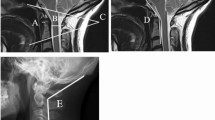Abstract
We present a retrospective study on a series composed of 50 patients, treated between 1992 and 2006, affected by pathologies of the craniocervical junction. All the patients were treated using an innovative procedure based on a cranial claw made up of low profile hooks, conceived by one of the authors. Advantages of this technique are, to our point of view, a higher resistance to cranial hooks dislodgment, when compared with screw fixation instrumentation, especially in pathological conditions, such as rheumatoid arthritis that leads to a qualitative deterioration of the bone stock and to the reduction of the occipital wall thickness. Occipitoaxial alignment was assessed radiographically using the McGregor line. We observed an improvement in the subjective evaluation of pain in all treated patients with a 46% improvement from the initial values. Moreover, patient stabilized with an occipitoaxial angle included in the physiological range showed better results either for the survival of the instrumentation or the onset of junctional pathology. Patients have been followed up afterwards and evaluated by the visual analogue scale for the assessment of pain and by the Nurick scale for the cases associated with myelopathy. We believe that cranial anchorage with a hook claw allows for an instrumentation provided with high stability, particularly useful in revision surgery and major instabilities. The study of the occipitoaxial angles showed that the better results and the long-lasting stability of the implant are correlated to a fusion angle included in the physiological range.

Similar content being viewed by others
References
Davey JR, Rorabeck CH, Bailey SI, Bourne RB, Dewar FP (1985) A technique of posterior cervical fusion for instability of the cervical spine. Spine 10:722–728
Ellis PM, Findlay JM (1994) Craniocervical fusion with contoured Luque rod and autogenic bone graft. Can J Surg 37:50–54
Förster O (1927) Die Leitungsbahnen des Schmerzgefühls und die chirurgische Behandlung der Schmerzzustände. Urban and Schwarzenburg, Berlin
Grob D, Dvorak J, Panjabi M, Froehlich M, Hayek J (1991) Posterior occipitocervical fusion: a preliminary report of a new technique. Spine 16(3):17–24
Kraus DR, Peppelman WC, Agarwal AK, DeLeeuw HW, Donaldson WF 3rd (1991) Incidence of subaxial subluxation in patients with generalized rheumatoid arthritis who had previous occipital cervical fusion. Spine 16:486–489
Logroscino CA, Casula S, Rigante M, Almadori G (2004) Transmandible approach for the treatment of upper cervical spine metastatic tumors. Orthopaedics 10:1100–1103
Logroscino CA, Diop A, Lavaste F (1996) Development of a new short metal construct for the treatment of severe craniocervical instability: biomechanical evaluation. Spine State Art Rev 10(2):315–325
Matsunaga S, Ijiri K, Koga H (2000) Results of a longer than 10-year follow-up of patients with rheumatoid arthritis treated by occipitocervical fusion. Spine 25:1749–1753
Matsunaga S, Onischi T, Sakou T (2001) Significance of occipitoaxial angle in subaxial lesion after occipitocervical fusion. Spine 26:161–165
McRae LD, Barnum SA (1953) Occipitalization of the atlas. AJR Am J Roentgenol 70:23–45
Nurick S (1972) The pathogenesis of the spinal cord disorder associated with cervical spondylosis. Brain 95:87–100
Oda T, Fujiwara K, Yonenobu K, Azuma B (1995) Natural course of cervical spine lesions in rheumatoid arthritis. Spine 20:1128–1135
Philips MF, Phillips SC, Wetzel TF, Gelinas C (1999) Occipitocervical neutral position: possible surgical implications. Spine 24:775–778
Shoda N, Takeshita K, Seichi A, Akune T, Nakajima S, Anamizu Y, Miyashita M, Nakamura K (2004) Measurement of occipitocervical angle. Spine 29:204–208
Steinbrocker O, Träger CH, Batterman RC (1949) Therapeutic criteria in rheumatoid arthritis. J Am Med Assoc 140:659–662
Conflict of interest statement
None of the authors has any potential conflict of interest.
Author information
Authors and Affiliations
Corresponding author
Rights and permissions
About this article
Cite this article
Logroscino, C.A., Genitiempo, M. & Casula, S. Relevance of the cranioaxial angle in the occipitocervical stabilization using an original construct: a retrospective study on 50 patients. Eur Spine J 18 (Suppl 1), 7–12 (2009). https://doi.org/10.1007/s00586-009-0985-x
Accepted:
Published:
Issue Date:
DOI: https://doi.org/10.1007/s00586-009-0985-x




